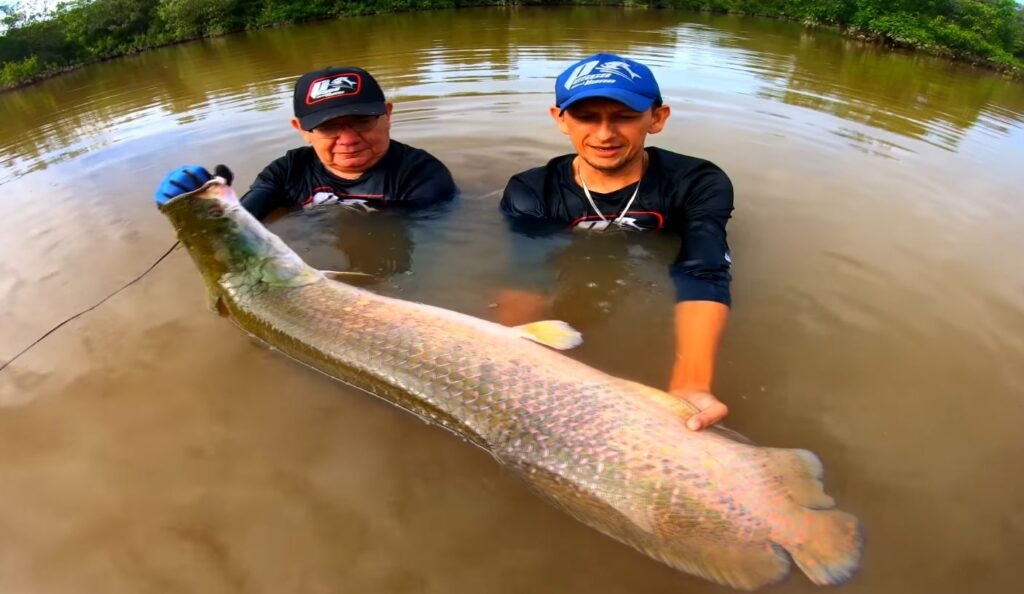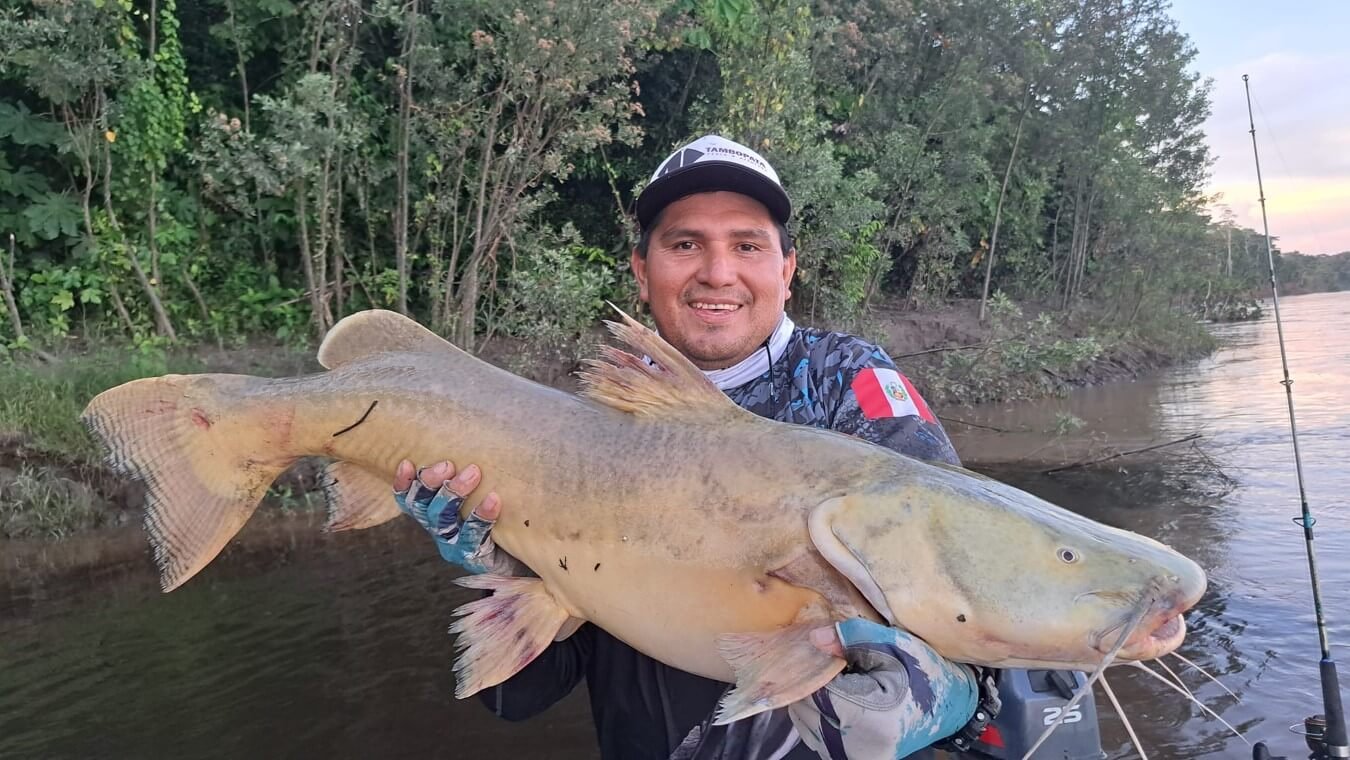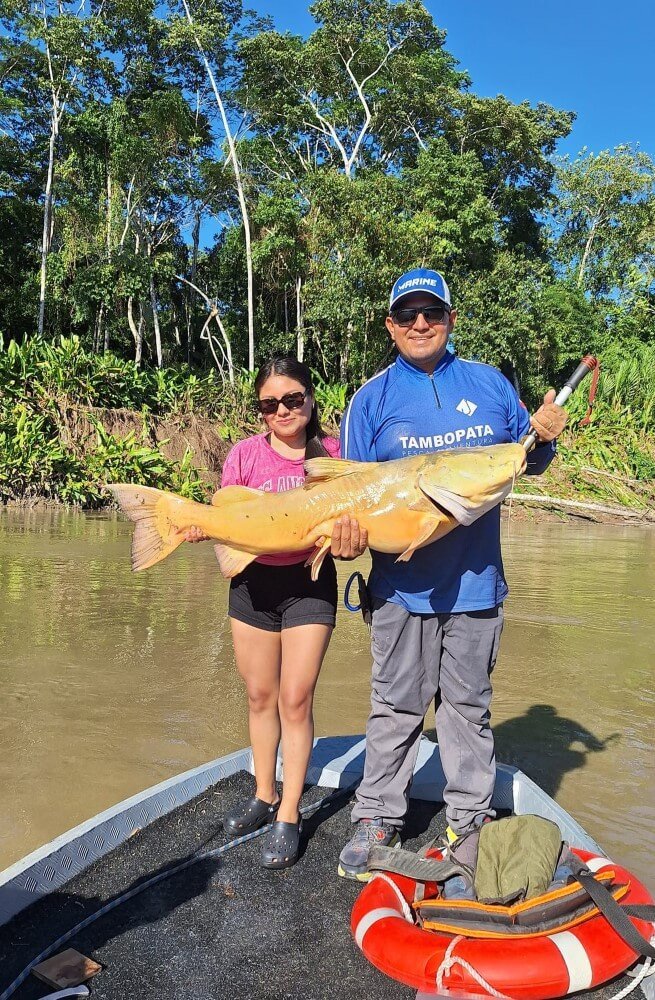The pirarucu (Arapaima gigas), also known as pirarucu, is one of the largest freshwater fish in the world. It is gaining prominence in the Amazon region of Ecuador. Although its origin lies in the Amazon basin, this impressive fish has been introduced to Ecuador. There, its breeding, sport fishing, and consumption are beginning to have a significant economic and ecological impact. In this blog, we will explore how the pirarucu is growing in importance in Ecuador. This is especially relevant in the Amazon provinces, where it plays a crucial role in sport fishing, aquaculture, and local gastronomy.

▶ The Pirarucu in Ecuadorian Amazonia
The Ecuadorian Amazon is famous for its rich biodiversity. Now, it is also incorporating the pirarucu into its bodies of water. Rivers like the Putumayo and the Napo provide the perfect environment for this aquatic giant. Although it is not native to Ecuador, its presence has expanded. This has happened due to its introduction into aquaculture projects and sport fishing activities. Local communities are beginning to take advantage of the economic benefits that the pirarucu offers. This includes both fish farming and sport fishing tourism.
▶ Sport Fishing for Pirarucu in Ecuador
The pirarucu has caught the attention of sport fishermen. Its enormous size and strength are the reasons for this. This species can reach up to three meters in length and weigh over 200 kg. This makes it a unique challenge for fishing enthusiasts. In Ecuador, sport fishing for the pirarucu is still in its early stages. However, it has started to generate interest, especially in the Amazon regions. There, tour operators offer experiences for catching this aquatic giant.

What makes sport fishing for the pirarucu even more exciting is its unique behavior. As an air-breathing fish, the pirarucu surfaces at regular intervals. This provides clues about its location and increases the tension for anglers. However, many operators promote catch-and-release practices. These practices are part of conservation and sustainability efforts, ensuring the preservation of the species while allowing enjoyment of the sport.
▶ Aquaculture of Pirarucu: Opportunities for Local Development
Alongside sport fishing, the aquaculture of pirarucu has started to develop in Ecuador. Regions like Sucumbíos and Orellana are focal points for this activity. Aquaculture has become a source of income for Amazonian communities. These communities have found in pirarucu farming a way to diversify their fish production, which has traditionally focused on species like tilapia. Thanks to its rapid growth and large size, the pirarucu offers great potential to meet local and foreign demand for its meat.

The aquaculture of pirarucu is not only an economic opportunity. It also represents a model of sustainability. In Ecuador, producers are implementing responsible practices. This ensures that the farming of pirarucu does not negatively impact native species or the Amazon ecosystem. This approach guarantees that pirarucu farming benefits local biodiversity and serves as a source of development for communities.
▶ Sustainability and Conservation of Pirarucu
The pirarucu is an introduced species in Ecuador. Therefore, its fishing and farming are regulated to avoid disrupting the local ecosystem. Catch-and-release in sport fishing is essential for its conservation. Additionally, sustainable practices in aquaculture help ensure that the pirarucu remains an economic and tourism resource. This does not jeopardize the biodiversity of the Ecuadorian Amazon.

The pirarucu is beginning to make its mark in Ecuador. Its presence is notable in sport fishing, aquaculture, and gastronomy. This giant of the Amazon offers significant economic opportunities for local communities. However, its management must be carried out carefully to protect the delicate Amazon ecosystem. If you visit the Ecuadorian Amazon, you cannot miss the chance to experience the thrill of sport fishing for the pirarucu. You can also enjoy a dish made with this unique fish.
▶ Frequently Asked Questions (FAQs)

⟹ What is the pirarucu?
The pirarucu (Arapaima gigas) is one of the largest freshwater fish in the world. It can reach up to three meters in length and weigh over 200 kg.
⟹ Where is the pirarucu found in Ecuador?
The pirarucu has been introduced in the Amazon region of Ecuador. It is particularly found in rivers like the Putumayo and the Napo, and in fish farms in Sucumbíos and Orellana.
⟹ Is the pirarucu a native species of Ecuador?
No, the pirarucu is not native to Ecuador. It was introduced to the Amazon region as part of aquaculture and sport fishing projects.
⟹ Is it possible to practice sport fishing for pirarucu in Ecuador?
Yes, although sport fishing for the pirarucu is in its early stages in Ecuador, it is possible to practice it in some areas of the Amazon. Many operators promote catch-and-release to protect the species.
⟹ How large can a pirarucu get?
The pirarucu can measure up to three meters long and weigh over 200 kg, making it a unique challenge for sport fishermen.
⟹ Is the pirarucu good for aquaculture?
Yes, the pirarucu is an excellent option for aquaculture due to its size and rapid growth. In Ecuador, sustainable projects for its farming are being developed in fish farms.
⟹ How is pirarucu cooked?
The meat of the pirarucu is very versatile. It can be prepared in many ways, such as grilled fillets, ceviche, or in stews. It is highly regarded for its mild flavor and texture.
⟹ Does the pirarucu affect the local ecosystem in Ecuador?
Although the pirarucu is an introduced species, aquaculture and sport fishing projects in Ecuador are regulated. This ensures they do not negatively impact native species or the ecosystem.

Are you ready to experience something unique with the giant of the Amazon? Don’t wait any longer. Book today and contact us to schedule your sport fishing adventure for pirarucu in the lush Amazon.
Sport Fishing Iquitos 4 Days
MORE INFORMATION HEREImagine the thrill of facing one of the largest freshwater fish in the world, all set against an incomparable natural backdrop. Our expert guides will take you to the best spots in rivers like the Putumayo and the Napo. There, you can test your fishing skills while learning about the ecological and cultural importance of this impressive species.





